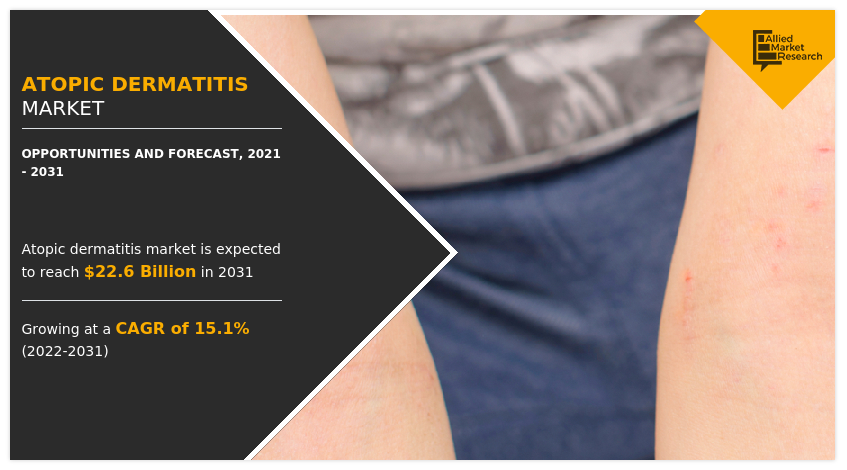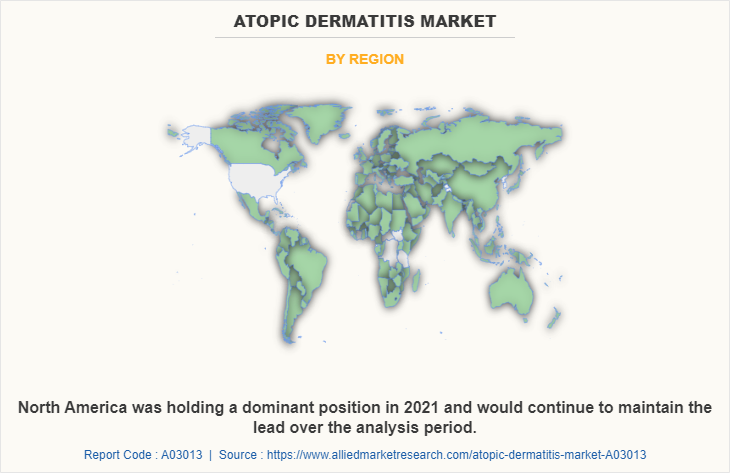Atopic Dermatitis Market Research, 2031
The global atopic dermatitis market size was valued at $5.3 billion in 2021, and is projected to reach $22.6 billion by 2031, growing at a CAGR of 15.1% from 2022 to 2031. Atopic dermatitis is a chronic disease that causes inflammation of the skin and results in red, itchy, swollen, and cracked skin. The affected area may result in white fluid discharge and will require treatment. Atopic dermis usually begins in childhood and may get severe with age. The cause for atopic dermatitis involves genetic disorder, environmental exposure, immune system malfunctioning, and difficulty in the permeability of skin.

Atopic dermatitis is a condition that causes skin to become dry, red, itchy and bumpy. It is one of many types of dermatitis. It damages the skin barrier function. This loss of barrier function makes the skin more sensitive and more prone to infection and dryness. Atopic dermatitis doesn’t harm the body. It doesn’t mean that the skin is dirty or infected, and its not contagious. There are treatments that can help manage the symptoms. In the word “dermatitis,” “derm” means “skin” and “itis” means “inflammation.” The word as a whole means “inflammation of the skin.” “Atopic dermatitis” originates from the Greek word “ekzein” which means to “boil over” or “break out.
According to American Journal of Managed Care, in 2017, atopic dermatitis affected up to 15 million Americans. Infants are prone to atopic dermatitis and 10% to 20% will have it. However, nearly half outgrow the condition or have significant improvement as they get older. Atopic dermatitis affects males and females equally and is more common in people who have a personal or family history of asthma, environmental allergies and/or food allergies. Atopic dermatitis can show up anywhere on the skin. In teens and adults, it’s typically found on your hands, neck, inner elbows, ankles, knees, feet, and around the eyes.
Dermatitis atopica market is expected to experience significant growth during the forecast period as there has been a rapid development of novel pipeline drugs is expected to accelerate the atopic dermatitis market size. Likewise, the rise in demand for new biologics and product approvals, and increase in number of atopic dermatitis industry are also predictable to enhance the atopic dermatitis market growth. Furthermore, the favorable reimbursement policies in emerging countries and high prevalence of atopic dermatitis are also projected to drive the market growth rate. Moreover, the increase in awareness regarding the availability of treatments for the disease and various initiatives undertaken by governments to provide better and more affordable treatment are also expected to influence the atopic dermatitis market share globally. In addition, the rapid technological advancement and the rise in funding along with increase in government support for research and development are likely to create various new opportunities that will impact the atopic dermatitis market growth during the forecast period.
However, the easy availability of expensive treatment and poor reimbursement policies in the developing regions across the globe are expected to act as major restraints toward the growth of the dermatitis atopica market, whereas the allergic reactions of off-label therapies and patent expiry of products can challenge the growth of the target market in the above mentioned atopic dermatitis market forecast forecast period.
Atopic dermatitis does not affect critical markets regularity in patients hospitalized with coronavirus. Adults with atopic diseases are at significant risk of lower respiratory tract infections (LRTIs) and upper respiratory tract infections (URTIs) than those without atopic diseases. Patients infected with corona virus didn’t face any difficulties during their infection course. Moreover, patients with atopic dermatitis are said to have efficient and safe therapy with dupilumab. During the COVID-19 pandemic period, the market teledermatology has increased due to a drop in the frequent clinical visits because of sanitary restrictions. Most of the patients with atopic dermatitis continue their generalized treatment, and patients should not stop their oral and biological therapy or other existing treatments without consulting their physicians. As per the National Eczema Association, the coronavirus pandemic crisis does not increase the threat of life-threatening issues in people with eczema. On the other hand, people with atopic dermatitis have higher incidences of anxiety and depression, and patients are found to account for increased occurrences in the emergency department. All these factors are expected to accelerate the growth rate of the global atopic dermatitis market.
Atopic Dermatitis Market Segmentation
The atopic dermatitis market share is segmented into drug class, mode of administration and distribution channel, and region. Depending on drug class, the market is classified into corticosteroids, calcineurin inhibitors, PDE4 inhibitors, biologics, and others. By indication, the market is classified into topical, injectable, and oral. According to end user, the market is segmented into hospital pharmacy, retail pharmacy, and online pharmacy. Region wise, the market is analyzed across North America (the U.S., Canada, and Mexico), Europe (Germany, France, the UK, Italy, Spain, and rest of Europe), Asia-Pacific (Japan, China, Australia, India, South Korea, and rest of Asia-Pacific), and LAMEA (Brazil, South Africa, Saudi Arabia, and rest of LAMEA).
Atopic Dermatitis Market By Drug Class
By drug class, the biologics segment currently dominates the global atopic dermatitis market and is expected to continue during the forecast period, owing to increase in awareness regarding the availability of treatments for the disease, and rise in various initiatives undertaken by governments to provide better and more affordable treatment. Moreover, new product launches and increased adoption of biological drugs across several regions is propelling the segment growth.
By Drug Class
Biologics segment held a dominant position in 2021 and would continue to maintain the lead over the forecast period.
Atopic Dermatitis Market By Mode Of Administration
By mode of administration, the injectable segment dominated the market in 2021, and this trend is expected to continue during the forecast period owing to increase in product approvals of drugs such as dupilumab.The launch of dupixent in 2017 proved to be a landmark in the injectables segment. Doctors have also started prescribing corticosteroids via injections for faster effects on patients.
By Mode Of Administration
Injectable segment held a dominant position in 2021 and would continue to maintain the lead over the forecast period.
Atopic Dermatitis Market By Distribution Channel
By distribution channel, the hospital pharmacies segment dominated the market in 2021, and this trend is expected to continue during the forecast period owing to high prevalence of atopic dermatitis, rise in prices of drugs, increasing income levels of poor & middle-class families, and approval of drugs.Moreover, growing number of inititatives from various governmental bodies in improving the infrastructure of hospitals and pharmacies are expected to expand the growth of the hospital pharmacies segment.
By Distribution Channel
Hospital Pharmacies segment is projected as one of the most lucrative segment.
Atopic Dermatitis Market By Region
By region, North America accounted for the largest market share in the atopic dermatitis market in 2021 and is expected to retain its dominance throughout the forecast period. This is primarily attributed to increasing prevalence of atopic dermatitis, high treatment awareness among the patient population, and advancement in atopic dermatitis industry. Moreover, well-established healthcare infrastructure, and early adoption of novel medications. For instance, as per the 2022 National Eczema Association, an estimated 16.5 million United States adults (7.3%) have atopic dermatitis that initially began at more than two years of age, with nearly 40% affected by moderate or severe disease. However, Asia-Pacific witnessed the highest growth rate for the atopic dermatitis market and is expected to continue this trend throughout the forecast period, which is attributed to strong presence of rapidly developing healthcare technology, huge patient population and rise in healthcare expenditure.

Competition Analysis
The major companies profiled in this report include AbbVie Inc., Arcutis Biotherapeutics, Inc., Asana Biosciences, Inc., Astellas Pharma, Inc., Bayer AG, Inc., Bristol-Myers Squibb Inc., Dermavant Sciences, Inc., Eli Lilly and Company, Inc., Galderma, Inc., Incyte Corporation, Inc., Leo Pharma, Inc., Novartis AG, Otsuka Pharmaceuticals Co., Ltd., Pfizer Inc., Regeneron Pharmaceuticals, Inc., Sanofi SA, Inc., and Viatris, Inc.
Key Benefits For Stakeholders
- This report provides a quantitative analysis of the market segments, current trends, estimations, and dynamics of the atopic dermatitis market analysis from 2021 to 2031 to identify the prevailing atopic dermatitis market opportunity.
- The market research is offered along with information related to key drivers, restraints, and opportunities.
- Porter's five forces analysis highlights the potency of buyers and suppliers to enable stakeholders make profit-oriented business decisions and strengthen their supplier-buyer network.
- In-depth analysis of the atopic dermatitis market segmentation assists to determine the prevailing market opportunities.
- Major countries in each region are mapped according to their revenue contribution to the global market.
- Market player positioning facilitates benchmarking and provides a clear understanding of the present position of the market players.
- The report includes the analysis of the regional as well as global atopic dermatitis market trends, key players, market segments, application areas, and market growth strategies.
Atopic Dermatitis Market Report Highlights
| Aspects | Details |
| By Drug Class |
|
| By Mode Of Administration |
|
| By Distribution Channel |
|
| By Region |
|
| Key Market Players | Viatris, Incyte, Arcutis Biotherapeutics, Astellas Pharma Inc., Dermavant, Regeneron Pharmaceuticals Inc., Sanofi SA, Galderma, AbbVie Inc., Asana Biosciences, Novartis International AG, Leo Pharma, Eli Lilly, Pfizer Inc., Bayer AG, Bristol-Myers Squibb, Otsuka Holdings Co.,Ltd |
Analyst Review
This section provides opinions of the CXOs of key companies operating in the atopic dermatitis market. According to the CXOs, the adoption of increase in treatment options for all age groups and severities is propelling the growth of the market. High ACOT is expected for novel agents such as biologics and JAK inhibitors. Also, some of the new JAK inhibitors are topical therapies that address key needs in the mild-to-moderate patient segment, with hopes that the inhibitors will not have any side effect of TCs and TCIs. As per the CXOs, atopic dermatitis is expected to witness increased adoption in the near future, owing to rise in number of immunization programs across the globe. In addition, the market is exhibiting high growth rate, owing to surge in awareness about use of the treatments.
By region, North America is expected to remain dominant during the forecast period, due to local presence of large in-house manufacturers like Bristol-Myers Squibb, Pfizer, and Regeneron Pharmaceuticals. Moreover, Asia-Pacific registered highest CAGR and is expected to remain dominant throughout the forecast period, owing to improvement in healthcare facilities, rise in disposable income, increase in awareness programs, and rapid improvement in economic conditions.
The top companies that hold the market share in atopic dermatitis market are AbbVie Inc., Arcutis Biotherapeutics, Inc., Asana Biosciences, Inc., Astellas Pharma, Inc., Bayer AG, Inc., Bristol-Myers Squibb Inc., Dermavant Sciences, Inc., Eli Lilly and Company, Inc., Galderma, Inc., Incyte Corporation, Inc., Leo Pharma, Inc., Novartis AG, Otsuka Pharmaceuticals Co., Ltd., Pfizer Inc., Regeneron Pharmaceuticals, Inc., Sanofi SA, Inc., and Viatris, Inc.
Asia-Pacific is expected to register highest CAGR of 16.2% from 2022 to 2031, owing to increase in rapidly developing healthcare technology, huge patient population and rise in healthcare expenditure.
The key trends in the atopic dermatitis market are the rise in demand for new biologics and product approvals, and increase in prevelence of atopic dermatics
The base year for the report is 2021.
Yes, atopic dermatitis companies are profiled in the report
The total market value of atopic dermatitis market is $5,333.37 million in 2021.
The forecast period in the report is from 2022 to 2031
The market value of atopic dermatitis market in 2022 was $6,357.38 million
Loading Table Of Content...


